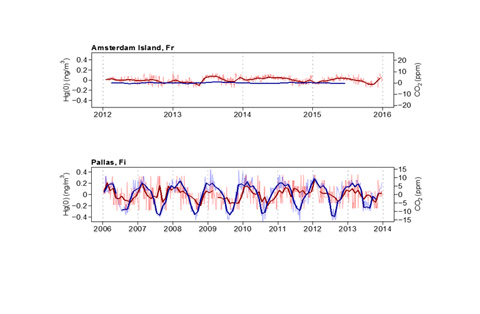Leaf uptake of Mercury lowers Global Air Pollution

Study led by researchers from the CNRS, the University Grenoble Alpes, found out that atmospheric CO2 levels fluctuate seasonally as vegetation takes up the gas through leaves to produce biomass. Consequently, CO2 levels are lower during summer compared to winter. By comparing mercury observations at 50 forested, marine, and urban monitoring stations, the study published in Nature Geoscience (March 26, 2018) finds that vegetation uptake of mercury is important at the global scale. The researchers estimate that the biological mercury pump annually sequesters half of all global anthropogenic mercury emissions.
New deposition pathway found
Each year industrial activities emit between two and three thousand metric tons of mercury into the atmosphere. With a long atmospheric lifetime of about 6 months, mercury emissions spread across the globe. What goes up must ultimately come down and this also applies to mercury. It has long been thought that atmospheric mercury deposition is predominantly by rainfall and snowfall, and monitoring networks measure mercury wet deposition worldwide. A slowly increasing number of experimental, field and modeling studies has suggested that plant leaves can also directly take up gaseous elemental mercury from the atmosphere. In fall, leaf mercury is then transferred to the underlying soil system by leaf senescence. Yet, the importance of this alternative deposition pathway, at the global scale, has never been fully appreciated.
To understand if leaf uptake of atmospheric mercury is important on the global scale, Martin Jiskra and Jeroen Sonke, from the Géosciences Environnement Toulouse laboratory, teamed up with scientists who monitor atmospheric mercury and CO2 levels across our planet. CO2 has a well-known seasonality with concentration minima in late summer, at the end of the vegetation and leaf growth season, and higher levels during winter. "To their surprise, the researchers found that mercury and CO2 show similar seasonal variations at five forested monitoring stations in the Northern hemisphere including Pallas", says researcher Katriina Kyllönen from FMI.
Observations of mercury and CO2 made at Amsterdam Island by Aurélien Dommergue and Olivier Magand from the Institut des Géosciences de l'Environnement (CNRS / UGA / IRD) and by Michel Ramonet and Marc Delmotte from the Laboratoire des Sciences du Climat et de l'Environnement (CEA / CNRS / UVSQ) turned out to be key in identifying the role of vegetation. At the Amsterdam Island station, operated by the French polar institute Paul Emile Victor and surrounded by 3000km of Ocean in all directions, both mercury and CO2 show near-zero seasonal variations (see Figure).
Next, the researchers turned to atmospheric monitoring databases from EMEP, AMNet and CAMnet, examining seasonal mercury observations for another 43 sites globally, but for which CO2 observations were lacking. They found that the amplitude of seasonal atmospheric mercury variations is largest at inland monitoring sites away from the coast. At all of the terrestrial sites they found strong inverse correlations between satellite observed photosynthetic activity and mercury concentrations. At urban monitoring stations the correlations were absent, and mercury seasonality controlled by local anthropogenic mercury emissions. The researchers conclude that vegetation acts as a biological pump for atmospheric mercury and plays a dominant role in the observed atmospheric mercury seasonality. By comparing the 20% amplitude of seasonal mercury variations to the known amount of mercury in the atmosphere (~5000 metric tons), they estimate that each year about 1000 tons of mercury is sequestrated in vegetation via leaf uptake. This amount is equal to half the annual global anthropogenic mercury emissions. They also suggest that the documented 30% increase in global primary productivity over the 20th century has likely enhanced uptake of atmospheric mercury, thereby practically offsetting increasing mercury emissions. Although leaf uptake removes mercury from air, autumn litterfall transfers the sequestered mercury to soils. Soil mercury ultimately runs off into aquatic ecosystems including lakes and Oceans where the mercury bioaccumulates to toxic levels in fish.
Observations at Pallas part of international measurements
The Pallas research infrastructure has been extensively instrumented for modern and versatile monitoring of the environment since the start of continuous monitoring of atmospheric sulphur dioxide (SO2) and ozone (O3) concentrations at Sammaltunturi in September 1991, and with the setup of the Global Atmosphere Watch (GAW) station in 1994. The measurement sites have contributed to numerous European and global research programs and research infrastructures. In 2009, the Academy of Finland recognized Pallas (together with the FMI Arctic research Centre at Sodankylä) as one of the most significant national research infrastructures in Finland. Mercury measurements have been conducted since 1996 in co-operation with Swedish Environmental Research Institute IVL.
The research was funded by H2020 Marie Sklodowska-Curie MEROXRE grant No 657195, European Research Council MERCURY ISOTOPES grant No 258537, IPEV programme 1028 GMOSTRAL, and the FP7 Environment GMOS grant No 265113.
More information :
Researcher Katriina Kyllönen, tel. +358 50 352 6722, etunimi.sukunimi@fmi.fi,
Main researcher :Martin Jiskra, Université de Toulouse (France) and University of Basel (Switzerland), firstname.lastname@unibas.ch, Tel: +41 (0) 7 88 36 55 82.
A vegetation control on seasonal variations in global atmospheric mercury, Martin Jiskra, Jeroen Sonke, Daniel Obrist, Johannes Bieser, Ralf Ebinghaus, Cathrine Myhre, Katrine Aspmo Pfaffhuber, Ingvar Wängberg, Katriina Kyllönen, Douglas Worthy, Lynwill Martin, Casper Labuschagne, Thumeka Mkololo, Michel Ramonet, Olivier Magand, and Aurelien Dommergue. Nature Geoscience, 26 march 2018. DOI: 10.1038/s41561-018-0078-8
https://www.nature.com/articles/s41561-018-0078-8

Figure. Gaseous elemental mercury (GEM, red) follows seasonal CO2 (blue) variations at the forested site of Pallas, reflecting leaf uptake of atmospheric mercury. The effect is absent at the oceanic site of Amsterdam Island (France) in the Indian Ocean. The study finds leaf uptake of mercury to be a globally important pathway of atmospheric mercury deposition.
